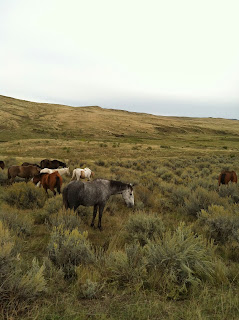October 1, 2013 - the day we planned to visit Mt. Rushmore was absolutely gorgeous, weather-wise. Our lovely campground in Custer City, SD had nice tall pines and was a good staging area for day trips. We visited with our host, Sue, about how to see the majestic carvings despite the Government Shutdown talked about on the news. We joked about how hard it would be for the government to hang a sheet or something over the granite faces of George, Abe, Tom, & Teddy!
We took the suggested "red" scenic route into Custer State Park and traveled Iron Mountain Road to the memorial. The curvy road had beautiful scenery and interesting loops, bridges, and low tunnels. We caught our first sighting of the memorial and quickly pulled into the turn-out for photos. All the while, I just knew we'd be able to drive right up to it and walk through the flags and such - surely just the visitor's center would be closed.
Well, not so - there were lots of orange cones, vehicles with flashing lights, and uniforms keeping us from turning into the gates. Very disappointed, we drove on and found a small turn-out to snap a few pictures. Several people were parking way up the road and literally hiking back, cameras in hand. With a sour-grapes attitude, we decided that at least we had been a part of history-in-the-making, having been at the great memorial for the first time in our lives on the very first day it was "closed for business" -
Well, not so - there were lots of orange cones, vehicles with flashing lights, and uniforms keeping us from turning into the gates. Very disappointed, we drove on and found a small turn-out to snap a few pictures. Several people were parking way up the road and literally hiking back, cameras in hand. With a sour-grapes attitude, we decided that at least we had been a part of history-in-the-making, having been at the great memorial for the first time in our lives on the very first day it was "closed for business" -
Crazy Horse Memorial was just 11 miles down the road - this privately funded park was open!
CLOSED!
Crazy Horse Memorial






















































